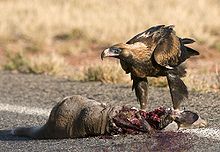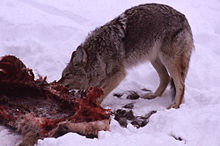- Carrion
-
Carrion (from the Latin "caro", meaning "meat") refers to the carcass of a dead animal. Carrion is an important food source for large carnivores and omnivores in most ecosystems. Examples of carrion-eaters (or scavengers) include vultures, hawks, eagles,[1] hyenas,[2] Virginia Opossum,[3] Tasmanian Devils,[4] coyotes,[5] Komodo dragons,[6] and burying beetles.[7] Many invertebrates like the burying beetles, as well as maggots of calliphorid flies and Flesh-flies also eat carrion, playing an important role in recycling nitrogen and carbon in animal remains.
Carrion begins to decay the moment of the animal's death, and it will increasingly attract insects and breed bacteria. Not long after the animal has died, its body will begin to exude a foul odor caused by the presence of bacteria and the emission of cadaverine and putrescine.
Some plants and fungi smell like decomposing carrion and attract insects that aid in reproduction. Plants that exhibit this behavior are known as carrion flowers. Stinkhorn mushrooms are examples of fungi with this characteristic.
The word carrion is often used in Danish mythology to describe animals that have been sacrificed and animals that have been killed due to the gods' fury.[citation needed]
Sometimes carrion is used to describe an infected carcass that is diseased and shouldn't be touched. An example of carrion being used to describe dead and rotting bodies in literature may be found in William Shakespeare's play Julius Caesar:
- Cry 'Havoc,' and let slip the dogs of war;
- That this foul deed shall smell above the earth
- With carrion men, groaning for burial.
- (III.i)[8]
Another example can be found in Daniel Defoe's Robinson Crusoe when the title character kills an unknown bird for food but finds "its flesh was Carrion, and fit for nothing." A third example can be found in J. R. R. Tolkien's The Lord of the Rings in a footnote in Appendix A. The dwarves resort to a mass burning of the bodies of their dead following the War of the Dwarves and Orcs "rather than leave their kin to beast or bird or carrion-orc."
In Islam, it is forbidden to eat rotting meat.[7]
References
- ^ Hovenden, Frank. "Comox Valley Naturalists Society: The Carrion Eaters". Comox Valley Naturalists Society. May 7, 2010. [1]
- ^ "San Diego Zoo's Animal Bytes: Striped hyena". San Diego Zoo. May 7, 2010. [2]
- ^ McDougall, Len. "Diet". The Encyclopedia of Tracks and Scats. Connecticut: The Lyon's Press, 2004. Print. (Page 274) [3]
- ^ "San Diego Zoo's Animal Bytes: Tasmanian Devil". San Diego Zoo. May 7, 2010. [4]
- ^ Stegemann, Eileen. "Skull Science: Coyote". NYS Department of Environmental Conservation April 2006: 1. [5]
- ^ Irvin, Randall. Attachment and Colonization of Pseudomonas aerugionsa: Role of the Surface Structures. Pseudomonas aeruginosa as an Opportunistic Pathogen. 1993.
- ^ Wood, J. G.. "Chapter VII". Insects Abroad. London: Longman, Greens And Co., 1892. Print. (Page 82) [6]
- ^ shakespeare.mit.edu
Wikimedia Foundation. 2010.


